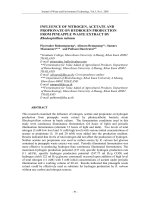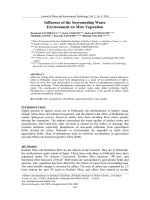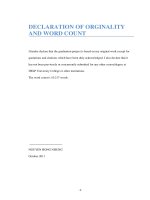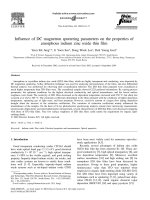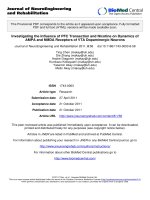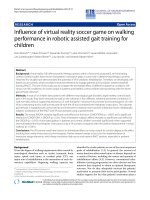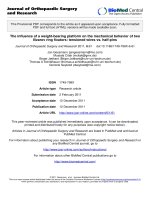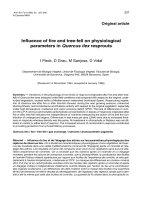Influence of various weed management approaches on weed dynamics in rice under different crop establishment methods
Bạn đang xem bản rút gọn của tài liệu. Xem và tải ngay bản đầy đủ của tài liệu tại đây (200.25 KB, 7 trang )
Int.J.Curr.Microbiol.App.Sci (2018) 7(3): 1551-1557
International Journal of Current Microbiology and Applied Sciences
ISSN: 2319-7706 Volume 7 Number 03 (2018)
Journal homepage:
Original Research Article
/>
Influence of Various Weed Management Approaches on Weed Dynamics in
Rice under Different Crop Establishment Methods
C.R. Netam1*, Rameshwari Netam2, A. Qureshi3, Kunti Banjare4 and A.K. Netam3
1
Department of Agronomy, College of Agriculture, G. B. Pant University of Agriculture and
Technology, Pantnagr, U.S. Nagar (Uttarakhand), India
2
Department of Seed Certification, Government of Chhattisgarh, India
3
College of Agriculture & Research Station, Kanker, Chhattisgarh, India
4
Scientist, KVK Bemetara, Chhattisgarh, India
*Corresponding author
ABSTRACT
Keywords
Crop establishment
methods, Weed
management, Weed
dynamics, Rice
Article Info
Accepted:
12 February 2018
Available Online:
10 March 2018
A field experiment was conducted for two consecutive rainy seasons of 2011 and 2012 at
G. B. Pant University of Agriculture and Technology, Pantnagar, U.S. Nagar
(Uttarakhand) to evaluate the “Influence of various weed management approaches on weed
dynamics in rice under different crop establishment methods”. The results revealed that the
lowest density and dry matter of total weeds at 60 days after sowing/days after
transplanting was obtained with transplanted rice. This treatment produced the highest
number of panicles/m2 and rice grain yield (4145 and 3879 kg/ha). Among the weed
management practices, application of bispyribac sodium 20 g/ha at 15 DAS/DAT followed
by one hand weeding at 35 DAS/DAT recorded the minimum population and dry matter of
total weeds and recorded the highest weed control efficiency which showed at par results
with the application of bispyribac sodium 22.5 g/ha at 2-3 leaf stage of weeds followed by
one HW at 35 DAS/DAT. This treatment produced the significantly higher number of
panicles/m2, grains/panicle and grain yield.
Introduction
In India, rice is the staple food for millions of
people and plays a vital role in the economy. It
is generally grown by transplanting in puddled
soil. Weeds are regarded as one of the major
limiting factors of the crop production. Weeds
share light, nutrients and water with the crop
and thus, interfere with rice growth and
production in many ways. The effective
control of weeds at initial stages (0-40 DAT)
can help in improving productivity of the crop.
There are various factors responsible for low
productivity of rice, in which weeds are
predominant ones. In India, transplanting is
the most common method of rice cultivation.
However, owing to its several limitations viz;
more labour and time consuming and
requiring a lot of expenditure on raising
nursery, it’s uprooting and transplanting. In
wet seeding, sowing of pre-germinated or
sprouted seeds on puddled soil reduce
substantially the cost of labour as it eliminates
the excess use of seedlings and related
1551
Int.J.Curr.Microbiol.App.Sci (2018) 7(3): 1551-1557
operations such as seedling nursery operation,
care of seedlings, pulling, bundling,
transportation and transplanting (Serrano,
1975). Sometimes farmers do not get chance
for weeding at appropriate time due to
preoccupation. Hand weeding in wet seeded
rice is more time consuming, cumbersome and
not as easy as in transplanted rice (Moody,
1983). Direct dry seeded rice (DSR) which
excludes puddling and drudgery of
transplanting the young rice seedlings provide
an option to resolve the edaphic conflict and
enhance the sustainability of rice-wheat
cropping system. Transplanted rice has
deleterious effects on the soil environment for
the succeeding wheat and other upland crops.
Puddling requires lot of scarce water at a time
when there is little water in the reservoirs,
destroys soil structure and adversely affects
soil productivity. Non-development of ground
water in kharif, late onset of monsoon and
drudgery of operations often delays rice
transplanting which leads to late vacation of
fields, forcing farmers to sow wheat after the
optimum time. DSR facilitates timely
establishment of rice and succeeding winter
crops. Unlike puddled fields, DSR fields do
not crack and thus, help in saving irrigation
water (Kumar, 2009).
Farmers growing direct seeded rice are likely
to encounter greater problems related to weed
management in absence of standing water.
The transition to direct seeding of rice can,
therefore, be successful only if accompanied
by effective weed management practices
(Singh et al., 2003). Weeds cause 50-60 per
cent grain yield reduction in puddled
conditions and 91 per cent in un-puddled
conditions (Ali and Sankaran, 1984). The use
of weeding tools damage the rice as they move
through the field, especially during early crop
growth, and they also fail to remove some of
the grassy weeds. Keeping these facts in view,
the present investigation was undertaken to
study the effect of crop establishment methods
and weed management practices on weed
dynamics and productivity of rice.
Materials and Methods
The field experiments was conducted in
Norman E. Borlaug Crop Research Centre,
Govind Ballabh Pant University of
Agriculture and Technology, Pantnagar, U.S.
Nagar (Uttarakhand) during two Rainy
seasons of 2011and 2012. The soil of the
experimental field was loam in texture. The
soil was found high in organic carbon
(0.87%), low in available nitrogen (262.0
kg/ha), medium in available phosphorus (21.8
kg/ha) and potassium (259.0 kg/ha) content
with neutral pH (7.2). An experiment was
conducted in split plot design with three
replications; keeping rice establishment
methods viz., direct dry seeded rice (DSR),
wet seeded rice (WSR- sprouted seeds) and
transplanted rice (TPR) in main plots and six
levels of weed management practices viz.
penoxsulam 22.5 g/ha at 2-3 leaf stage of
weeds, penoxsulam 22.5 g/ha at 2-3 leaf stage
of weeds followed by (fb) one hand weeding
(HW) at 35DAS/DAT, bispyribac sodium 20
g/ha at 15DAS/DAT, bispyribac sodium 20
g/ha at 15DAS/DAT fb one hand weeding at
35DAS/DAT, weed free and weedy check in
sub plot.
In direct dry seeded rice, seeds were sown in
lines 20 cm apart by using 40 kg/ha seed rate
and covered by soil; while, sprouted seeds
were sown in rows 20 cm apart in wet seeded
rice by using manually operated drum seeder.
Twenty one day old seedlings were
transplanted in transplanting method and
cultivar Sarju-52 was used in experiment. In
direct dry seeding rice seed was sown on 11
June, 2011 and 21 June, 2012 during first and
second year, respectively. Seed was water
soaked for wet seeding and nursery raising for
transplanting to same date of seed sown in
direct dry seeding. Crop was fertilized
1552
Int.J.Curr.Microbiol.App.Sci (2018) 7(3): 1551-1557
uniformly with 150:60:40 kg/ha of N, P2O5
and K2O, respectively through the use of NPK
mixture (12:32:16), urea (46:0:0) and muriate
of potash (0:0:60). Total amount of
phosphorus was applied through NPK mixture
while, nitrogen through NPK mixture and urea
and potassium through NPK mixture and
muriate of potash. The full amount of
phosphorus and potassium and half dose of
nitrogen were applied as basal just before
sowing of rice seed/transplanting of rice
seedling. Remaining half of the nitrogen was
top dressed through urea in two splits; first at
active tillering and second at panicle initiation
stage in all methods of rice establishment.
significantly superior to Direct Seeded Rice.
This might be due to effective control of all
categories of weeds during intensive puddling,
which was started two weeks before
transplanting and sufficient time allowed for
germination of weed seeds present in the soil.
Amongst weed management methods, lower
density of grasses, broad-leaved weeds and
sedges at60 DAT and higher weed control
efficiency (Table 1, 3) was recorded with
Bispyribac sodium 20 g/ha fb one HW at 35
DAS/DAT followed by Penoxsulam 22.5 g/ha
fb one HW at 35 DAS/DAT.
Density and dry matter of weeds were
recorded at 60 DAS/DAT days after seeding
with the help of quadrate (0.5 x 0.5 m) and
then converted in per square meter. Data on
weeds were subjected to square root
transformation before statistical analysis to
normalize their distribution. All the data were
analyzed by using ANOVA, and the least
significant difference (LSD) value at 5% level
of significance were calculated and used to
test significant differences between treatment
means.
Bispyribac sodium 20 g/ha at 15 DAS/DAT fb
one HW at 35 DAS/DAT followed by
Bispyribac sodium 20 g/ha at 15 DAS/DAT
had significantly lower broad-leaved weeds
and sedges and higher weed control efficiency
as compared to the Penoxsulam22.5 g/ha at 23 leaf stage of weeds fb one HW at 35
DAS/DAT followed by Penoxsulam22.5 g/ha
at 2-3 leaf stage of weeds at 60 DAT. This
was due to integration of chemical and
mechanical method of weed control resulting
in broad-spectrum control of weeds, reported
by Mukherjee and Maity (2011).
Results and Discussion
Effect on rice growth
Total weed density
In case of rice transplanting methods,
transplanting rice recorded significantly higher
plant height (cm), No. of shoots (cm), Crop
dry matter (g m-2), dry matter accumulation
and leaf area index as compared to Direct
seeded rice (Table 2). It might be due to low
crop weed competition on growth attributes in
transplanting rice as compared to direct seeded
rice. Amongst weed control methods,
Bispyribac sodium 20 g/ha fb one HW
followed by Penoxsulam 22.5 g/ha fb one HW
recorded significantly higher plant height, no.
of tillers/hill, dry matter accumulation and leaf
area index.
The experimental field was infested with
grassy weeds, viz. Echinochloa colona,
Echinochloa crusgalli, Cynodon dactylon,
Panicum repens and Paspalum distichum;
broad-leaved weeds, viz. Ammania baccifera,
Eclipta alba, Caesulia axillaris, Commelina
benghalensis, Euphorbia hirta and Ludwigia
parviflora; and sedges, viz. Cyperusiria,
Cyperus difformis and Fimbristylis miliaceae.
Method of rice transplanting significantly
influenced the weed density at 60 DAT (Table
1). The lower weed density was recorded
under Transplanted Rice, which was
1553
Int.J.Curr.Microbiol.App.Sci (2018) 7(3): 1551-1557
Table.1 Effect of crop establishment methods and weed management practices on weed density at 60DAS/DAT
(Pooled mean of 2 years)
Weed density (no./m2)
Treatment
Rice establishment method
Direct seeded rice
Wet seeded rice
Transplanted rice
SEm±
LSD (P=0.05)
Weed management practice
Penoxsulam 22.5 g/ha
Penoxsulam 22.5 g/ha fb one HW at 35 DAS/DAT
Bispyribac sodium 20 g/ha
Bispyribac sodium 20 g/ha fb one HW at 35 DAS/DAT
Weed free
Weedy check
SEm±
LSD (P=0.05)
Total weed density (no./m2)
Grasses
Broad-leaved weeds
Sedges
6.67 (74.7)
5.4 (38.6)
4.48 (26.8)
0.28
1.1
3.49 (15.2)
2.28 (9.4)
1.96 (7.8)
0.21
0.31
4.15 (22.9)
3.5 (15.9)
2.6 (10.8)
0.48
NS
3.7 (126.0)
3.3 (73.1)
2.8 (51.7)
0.08
0.33
7.8 (48.2)
3.88 (11.1)
7.43 (43.6)
3.23 (8.5)
0
12.11 (353.1)
0.46
1.33
3.39 (10.4)
0.66 (1.8)
4.06 (13.3)
0.99 (2.4)
0
6.3 (36.9)
0.54
1.565
4.25 (13.8)
0.54 (1.3)
4.88 (18.4)
1.03 (2.67)
0
8.7 (58.7)
0.52
1.48
4.4 (84.3)
2.6 (16.0)
4.4 (89.4)
2.6 (15.6)
0
5.7 (297.8)
0.14
0.40
Original values given in parentheses, DAS- Days after sowing, DAT- Days after transplanting, fb- followed by, HW- hand weeding, NS- Non-significant
Table.2 Effect of crop establishment methods and weed management practices on growth attributes in rice at 60DAS/ DAT
(Pooled mean of 2 years)
Treatment
Rice establishment method
Direct seeded rice
Wet seeded rice
Transplanted rice
SEm±
LSD (P=0.05)
Weed management practice
Penoxsulam 22.5 g/ha
Penoxsulam 22.5 g/ha fb one HW
Bispyribac sodium 20 g/ha
Bispyribac sodium 20 g/ha fb one HW
Weed free
Weedy check
SEm±
LSD (P=0.05)
Plant height (cm)
Number of shoots (m-2)
Crop dry matter (g m-2)
Leaf Area Index
69.87
71.62
71.56
0.45
NS
216
238
244
3.58
13.99
297.24
327.81
334.29
4.92
19.25
3.50
3.68
3.77
0.07
NS
69.59
73.40
70.72
73.62
75.36
63.70
0.69
2.0
209
286
208
286
298
109
6.54
18.90
282.79
394.56
280.92
395.02
418.53
146.84
8.97
25.89
3.31
4.31
3.31
4.31
4.37
2.28
0.19
0.55
DAS- Days after sowing, DAT- Days after transplanting, fb- followed by, HW- hand weeding, NS- Non-significant
1554
Int.J.Curr.Microbiol.App.Sci (2018) 7(3): 1551-1557
Table.3 Effect of crop establishment methods and weed management practices on yield attributes, yield, weed index and weed control
efficiency (Pooled mean of 2 years)
Treatment
Yield attributes
Number of
panicles/m2
Panicle
Grains/ Test weight
length (cm) panicle (g/1000 seeds)
Grain
yield
(t/ha)
Weed
index
(%)
Weed
control
efficiency (%)
Rice establishment methods
Direct seeded rice
174.42
25.04
154.44
23.49
3.30
34.73
75.95
Wet seeded rice
197.47
25.19
156.36
23.66
3.61
29.79
76.35
Transplanted rice
218.36
25.43
158.72
23.76
4.01
23.61
76.95
SEm±
2.05
0.29
0.82
0.13
0.06
1.30
0.50
CD (P=0.05)
8.02
NS
3.21
NS
0.22
Penoxsulam22.5 g/ha at 2-3 leaf stage
of weeds
157.39
24.77
152.33
23.33
2.90
43.70
80.00
Penoxsulam22.5 g/ha at 2-3 leaf stage
of weedsfb one HW at 35 DAS/DAT
262.00
25.80
162.33
23.91
4.86
5.54
99.00
Bispyribac sodium 20 g/ha at 15
DAS/DAT
159.56
24.73
152.11
23.61
2.91
43.32
80.25
Bispyribac sodium 20 g/ha at 15
DAS/DAT fb one HW at 35 DAS/DAT
264.28
25.66
163.67
23.91
4.92
5.18
99.05
Weed free
277.83
26.03
167.72
24.08
5.14
0.00
100.00
Weedy check
59.44
24.32
139.61
22.98
1.11
78.52
0.00
SEm±
5.58
0.50
1.98
0.21
0.09
1.39
0.66
LSD (P=0.05)
16.10
NS
5.71
NS
0.25
4.01
1.87
NS
Weed management practices
DAS- Days after sowing, DAT- Days after transplanting, fb- followed by, HW- hand weeding, NS- Non-significant
1555
Int.J.Curr.Microbiol.App.Sci (2018) 7(3): 1551-1557
This might be due to comparatively less weed
competition for nutrients, and better weed
control. resulted in significantly higher plant
height, no. of tillers/hill, and dry matter
accumulation and leaf area index in
comparison to conventional scheduling of
nitrogen. The significant variations in growth
attributes were observed due to nitrogen
application when needed by crop as observed
by Islam et al., (2009).
Rice yield and weed control efficiency
The differences in 1000-grain weight were
non-significant due to rice transplanting
method. Transplanted rice had significantly
higher number of panicles/hill, no. of
grains/panicle and higher grain yield as
compared to direct seeded rice (Table3).
Higher values of yield attributes and grain
yield under transplanted rice were perhaps
due to better partitioning of photosynthates
from source to sink as a result of lower cropweed competition owing to favourable
growing conditions in transplanting rice. The
results were corroborated with the findings of
Jaiswal and Singh (2001).Amongst weed
control treatments, Bispyribac sodium 20 g/ha
at 15 DAS/DAT fb one HW at 35 DAS/DAT
followed by Penoxsulam22.5 g/ha at 2-3 leaf
stage of weeds fb one HW at 35 DAS/DAT
had significantly more 1000-grain weight, no.
of panicles/ hill, no. of grains/panicle and
grain yield. This might be due to effective
control of weeds which in turn significantly
increased the no. of panicles/hill and
grains/panicle consequently improving the
grain yield. Control of weeds by herbicides
during early stages of rice followed by
Penoxsulam 22.5 g/ha at 2-3 leaf stage of
weeds fb one HW at 35 DAS/DAT resulted in
lower competition for growth resources that
influenced the crop to grow better as
evidenced in increased yield attributes.
Similar findings were also observed by Singh
et al., (2005) and Ramachandra et al., (2012).
Resulted in significantly more 1000-grain
weight, no. of panicles/hill, grains/panicle and
grain yield in comparison to conventional
scheduling of nitrogen application. Higher
values of yield attributes and grain yield were
probably owing to more utilization and uptake
of nitrogen at active growing stages, viz.
tillering and panicle initiation. Similar
findings were also observed by Awas the
(2009) and Gill and Walia (2013).It can be
concluded that Bispyribac sodium 20 g/ha at
15 DAS/DAT fb one HW at 35 DAS/DAT
followed by Penoxsulam22.5 g/ha at 2-3 leaf
stage of weeds fb one HW at 35 DAS/DAT,
under transplanting could be recommended
for effective weed management and higher
rice yield.
References
Ali, M. A. and Sankaran, S. 1984. Crop-weed
competition in direct seeded low land
and upland bunded rice. Indian J. Weed
Sci.16: 90-96.
Awasthe R. 2009. Nitrogen management in
transplanted rice (Oryza sativa) in midhill acidic soils of Sikkim Himalayas.
Indian Journal of Agronomy 54(1): 4751.
Combination with metsulfuron-methyl on
weed control in transplanted rice.
Mysore Journal of Agricultural
Sciences 44(2): 246-254.
Gill JS and Walia SS. 2013. Effect of
establishment methods and nitrogen
levels on basmati rice (Oryza sativa).
Indian Journal of Agronomy 58(4): 506511.
Islam MS, Hasanuzzaman R and Nahar K.
2009. Effect of split application of N
fertilizer on morpho-physiological
parameters
of
rice
genotypes.
International
Journal
of
Plant
Production 3(1): 51–62.
Jaiswal VP and Singh GR. 2001.Effect of
planting methods, source and level of
1556
Int.J.Curr.Microbiol.App.Sci (2018) 7(3): 1551-1557
nitrogen on the growth and yield of rice
(Oryza sativa) and on succeeding wheat
(Triticum aestivum). Indian Journal of
Agronomy 46(1): 5-11.
Kumar,
R.
2009.
/>ect-seeded-rice
(Submitted
by
shuklarajeew on Tue, 30/06/2009 16:57).
Moody, K. 1983. The status of weed control
in rice in Asia. In Proceeding in Women
in Rice Farming. International Rice
Research Institue, Los Banos, Laguna,
Philippines. pp 467-480.
Mukerjee, P. K., and Maithy, S. K. 2011.
Weed control in transplanted and wet
seeded rainy season rice. Indian J.
Agric. Sci. 81(2):134-139.
Ramchandra, C., Denesh, G. R. and
Sydanwarulla 2010. Weed management
practices in transplanted rice by using
glyphosate. Biennial Conference on
“Recent Advances in Weed Science
Research -2010”, February 25-26, 2010,
Indira Gandhi Krishi Vishwavidyalaya,
Raipur (CG). 63p.
Serrano, F. B. 1975. Twenty-six Years of
Rice Research and Development.
National Research Council of the
Philippines, Diliman, Quezon City,
Philippines, 122p.
Singh, G., Singh, V. P., Singh, V., Singh, S.
P., Kumar, A., Mortimer, M. and
Johnson, D. E. 2005. Characterization
of weed flora and weeds management
practices in rice under different
cropping systems in Western Gangetic
plains of India. Indian J. Weed Sci.,
37(1&2): 45-50.
Singh, G., Singh, Y., Sing, V. P., Singh, R.
K., Singh, Pratibha; Johnson, D. E.,
Mortimer, M., and Orr. A. 2003. Direct
seeding
as
an
alternative
to
transplanting rice for the rice – wheat
system of the Indo-gangetic plains.
Sustainability issues related to weed
management. Proc. BCPC Conferencecrop science and technology. F-9: pp
1035-1040.
How to cite this article:
Netam, C.R., Rameshwari Netam, A. Qureshi, Kunti Banjare and Netam, A.K. 2018. Influence
of Various Weed Management Approaches on Weed Dynamics in Rice under Different Crop
Establishment Methods. Int.J.Curr.Microbiol.App.Sci. 7(03): 1551-1557.
doi: />
1557
